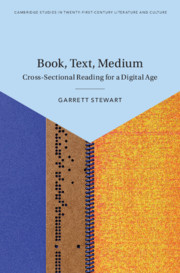Book contents
- Book, Text, Medium
- Cambridge Studies in Twenty-First-Century Literature and Culture
- Book, Text, Medium
- Copyright page
- Dedication
- Contents
- Figures
- Prospectus
- Intro\Retro
- Part I The Hold of the Codex
- Part II The Grip of Inscription
- Chapter 3 Reading In
- Chapter 4 Reading Out
- Part III The Give of Medium
- Notes
- Index
Chapter 4 - Reading Out
from Part II - The Grip of Inscription
Published online by Cambridge University Press: 21 December 2020
- Book, Text, Medium
- Cambridge Studies in Twenty-First-Century Literature and Culture
- Book, Text, Medium
- Copyright page
- Dedication
- Contents
- Figures
- Prospectus
- Intro\Retro
- Part I The Hold of the Codex
- Part II The Grip of Inscription
- Chapter 3 Reading In
- Chapter 4 Reading Out
- Part III The Give of Medium
- Notes
- Index
Summary
Between the last chapter and this, silence changes its sign. Compared to the ludicrous reading in of significance to the visual filler of screen text is the normal reading out of sound from visual signs. Clarified by audio theorist Michel Chion are the different time frames of cinematic montage and alphabetic signage on screen. Pursuing the theme of temporality and writing, a literary-critical debate between Michael Riffaterre and Paul de Man over a poem by Victor Hugo turns on the poem’s lack of book or page for its text/medium interface – with indirect consequences for its phonetic substrate as well. From there, discussion moves to a famous auditory passage in Virginia Woolf and to a debate in media and film theory that returns to Chion in explicating the difference between the filmic photogram and a linguistic “phonogram,” the latter on exhibit in such novelists as Tom McCarthy and Don DeLillo.
Keywords
- Type
- Chapter
- Information
- Book, Text, MediumCross-Sectional Reading for a Digital Age, pp. 118 - 138Publisher: Cambridge University PressPrint publication year: 2021



